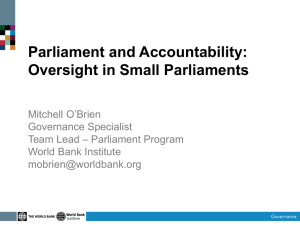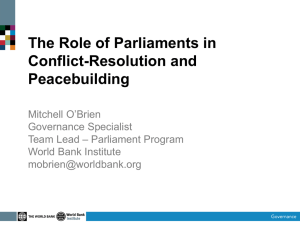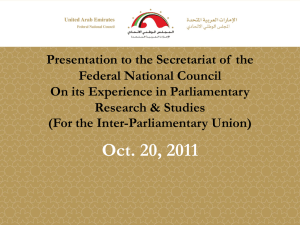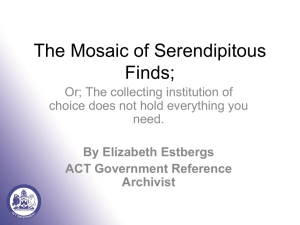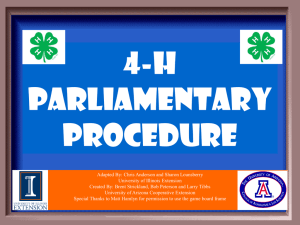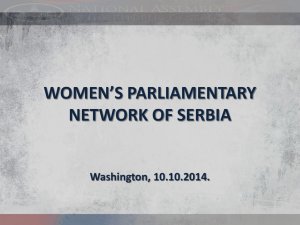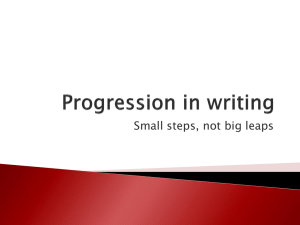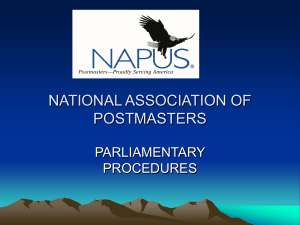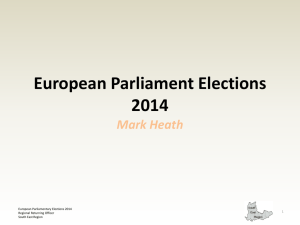15 - Capacity4Dev
advertisement
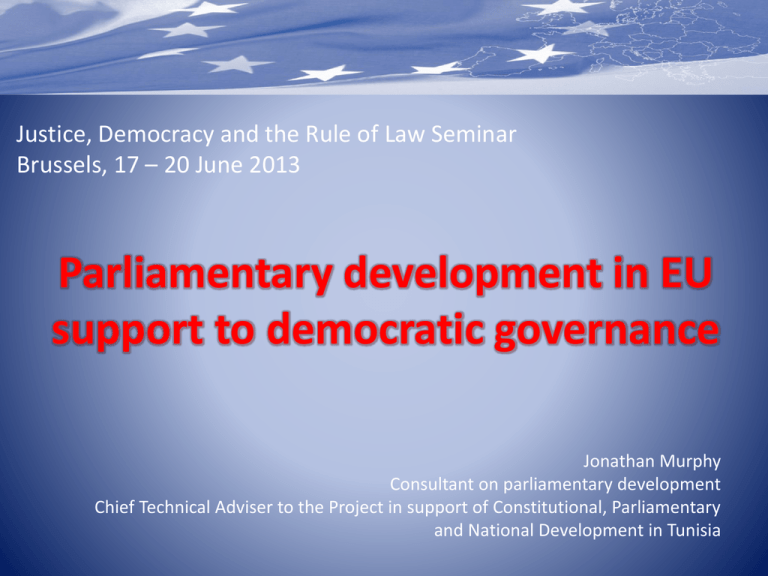
Justice, Democracy and the Rule of Law Seminar Brussels, 17 – 20 June 2013 Parliamentary development in EU support to democratic governance Jonathan Murphy Consultant on parliamentary development Chief Technical Adviser to the Project in support of Constitutional, Parliamentary and National Development in Tunisia PRESENTATION CONTENTS 1. Parliamentary development in democracy support 2. Support to the democratic transition in Tunisia 3. Performance indicators in parliamentary development 2 1. The logic of parliamentary development PARLIAMENTS AND DEMOCRATIC DEVELOPMENT 3 Parliaments and democracy • Parliaments – places where issues are debated and decided - have existed in various forms in different regions of the world for several thousand years • Although historically there have been attempts to build democracies without parliaments, parliaments exist in all modern democracies • Parliaments represent the formal link between the citizen and civil society and the state • Substantial research evidence (example Valerie Bunce, 2008, Stephen Fish, 2009) demonstrates link between strong parliaments and stable democracies • The classic roles of parliaments include legislation, oversight of the executive, and representation of the citizen. 4 Criticisms of parliaments • Parliaments are weak and marginalized vis-àvis the executive • Represent a purely formal and processual type of democracy • Civil society can be the foundation of a participatory democracy • Parliaments are themselves elite institutions 5 Responses to critiques • Although parliaments in emerging democracies often have these weaknesses, the need is to strengthen rather than build parallel legitimacies • Donors have an important role both directly in supporting parliamentary development and in avoiding undermining parliaments in aid practices • Civil society is essential to democracy, but parliaments are the key channel to bring the voice of civil society to the policy-making level 6 EU support to parliaments EC has been supporting parliamentary development for the past twenty years Over the past decade there have been over 50 EUsupported parliamentary development projects in 30 countries EU has also supported several regional parliaments, as well as included parliament development within a number of budget support programmes The total value of EC support to parliamentary strengthening over the past decade is over €100 million 7 Thinking about Parliamentary Development 1. Impact takes time 2. Performance assessment must be integrated in project design and implementation 3. Relationship between effective parliaments and democracy key in project design and evaluation, 4. Parliaments’ place in an international institutional ecosystem strongly influences organizational behaviour and ambitions 5. Parliamentary development, like all international development, needs to be country owned and driven. 8 2. CASE STUDY: Project in support of Constitutional, Parliamentary and National Development in Tunisia 9 Project background • Project established after the Tunisian Revolution launched the Arab Spring in January 2011 • Contains three elements – 1) support to the Constituent Assembly in the development of the new Constitution, 2) Longer term support for parliamentary institutional development, 3) Support to national dialogue through civil society • Funded by Japan, Belgium, Sweden, EU, Denmark, Norway • Delivered by UNDP • Budget of $18 million from 2012 to 2015 10 Project achievements • Underpinned the national consultation process on the constitutional drafts; built consensus on the need for continuing citizen engagement in political processes • Supported development of financial and administrative autonomy • Built partnerships with parliaments including the EP and several EU member state parliaments – sustainability strategy • Developed understanding of role of political opposition and of parliamentary groups in the Assembly 11 Transition challenges • Country has never known democratic system; risk of authoritarian reflex • Divergence in societal vision between ‘Mediterranean secularist’ and ‘Arab Muslim’ • Difficult economic situation exacerbated by absence of strong government • Potential security risks • Weak or discredited state institutions including parliament and parliamentary administration 12 Delivery challenges • Large programme funded over short time during busy period for dual-responsibility Assembly – pushing at limits of absorption capacity • Some misalignment between donor funding cycle and realities of the extended constitutional process • Need to implement rapidly while respecting UN administrative processes 13 Cibles et indicateurs Cible 1. Les capacités de rédaction des textes constitutionnels et législatifs de l’Assemblée constituante sont renforcées Indicateurs : 1.1. Les membres des 6 commissions constituantes sont formés aux procédures et techniques d’élaboration des textes constitutionnels et utilisent les connaissances acquises dans leur travail ; Cible 2. Les citoyens dans les différentes régions du pays sont sensibilisés sur le processus constitutionnel et bénéficient de l’opportunité d’exprimer leurs attentes en la matière Indicateurs : 2.1. Un plan de consultation publique, permettant de collecter les attentes des groupes vulnérables et des régions défavorisées dans le cadre du processus constitutionnel, est élaboré et mis en œuvre 2.2. Des auditions publiques sur le processus constitutionnel sont organisées dans au moins 5 régions défavorisées par l’Assemblée constituante 2.3. 3 auditions thématiques au moins sont organisées par l’Assemblée constituante sur les questions essentielles, telles que l’intégration des DH, de l’égalité de genre et des autres principes démocratiques dans la constitution 2.4. 5 projets au moins sont mis en œuvre en partenariat avec la société civile pour le dialogue constitutionnel et l’éducation civique des groupes vulnérables - - - - Résultats 42 membres et conseillers de l'Assemblée ont été formés sur les techniques de consultation publique 300 représentants de la société civile ont participé à la consultation sur le 1er projet de Constitution Les questeurs et les fonctionnaires de l'administration parlementaire ont été sensibilisés sur l'indépendance financière de l'Assemblée et son intégration dans la Constitution 300 participants ont été sensibilisés à l'importance de la constitutionnalisation de l'égalité de genre et de la participation politique des femmes 320 représentants des universités ont participé à des consultations sur le projet de Constitution 25 élus ont été formés sur le processus législatif et constitutionnel, sur la base des bonnes pratiques internationales. 1034 citoyens et représentants de la société civile ont été impliqués dans le processus de consultation nationale avec 80 élus de l'ANC dans 12 gouvernorats du pays. 14 3. Measuring Impact PERFORMANCE INDICATORS IN PARLIAMENTARY DEVELOMENT 15 Importance of measuring impact of democratic development initiatives • Democratic development often seen as lacking in focus and with questionable impact • Contrasted with ‘direct’ support to alleviate poverty • Nevertheless poor governance is routinely identified as a key cause and exacerbating factor in poverty • Need to better understand how and why some approaches work better than others 16 Challenges in performance and impact measurement • Problem of macro-outcome measurement (for example, the quality of democracy overall) impact on which is unlikely to be measurable through a small PD project • Alternatively measurement of outputs (number of people trained, delegations sent on study missions, etc.) • Objective is to identify meso indicators: change factors that improve institutional funding and are linked to institutional efficiency and effectiveness 17 Levels of evaluation and performance measurement 1. Programme Theory Evaluation Documentation of intervention logic, actor chain and internal transformations and external interventions Established at program development stage, reassessed at interim evaluation, based on data from monitoring reports and ongoing output monitoring and measurement . Overall programme logic viability evaluated at final evaluation 2. Outcome or Impact Evaluation Assessment of progress towards major programme objectives Major programme objectives determined at project development and included in project design and logical framework, documented through programme reporting, monitored through monitoring reports and and evaluated at final evaluation 3. Output monitoring and measurement Programme reporting based on indicators and activity plans in project design (Action Fiche and logical framework) Data gathered on continuing basis by programme management, permitting assessment of progress to major programme objecrtives,.Major divergence from staged indicators triggers re-assessment of objectives. Consolidated data feeds into external mid-point and end-point evaluations 18 Programme logic evaluation • A crucial step in effective measurement is a clear theory of change and logic of intervention • Monitoring and evaluation must assess the extent to which the programme logic supports the actions outcomes that are sought, and the interventions undertaken to bring them about. • As programme design hypotheses are confirmed or rejected, projects need to be revised, with anticipated outcomes as well as interventions adjusted. 19 Main areas of PD intervention activities 1. Legislation 5. Administration 2. Oversight 6. Inclusivity 3. Budget 7. Institution-building 4. Representation 20 Example of outcomes in Oversight strengthening • Parliament consistently and effectively uses the available range of oversight tools • Improved dialogue and collaboration with civil society on policy oversight issues • Enhanced expert capacity of legislative committee staff to provide expert support and advice on oversight 21 Outcome Indicative activities supported Outcome indicators 1. Training provided to parliamentarians, committee, and party caucus staff on oversight tools and their use Measurable: Parliament consistently and effectively uses the available range of oversight tools Exchange missions of oversight committees (for example, Public Accounts Committees) with homologue parliaments with established oversight capacity Preparation of oversight handbook for MPs Tracking increased use of each oversight instrument, e.g. questions, interpellations, missions of enquiry, etc. Assessment/ Measurement methodology Should be captured by standard legislature record-keeping. If not, provide support to establish such a system Qualitative: Increased focus on oversight in committee deliberations The qualitative indicators require analysis before and after Support establishment of annual intervention. This should include planning process and linked Improved quality of oversight assessment through focus group parliamentary budget line item for each processes (for example more inmethodology (also involving legislative committee, permitting external actors including media oversight work (e.g. hearings in the field, depth reports on policy implementation) and civil society). Should be engaging experts) initiated before programme Where oversight tools are inadequate Adoption of new analytical tools commencement and be due to weaknesses in parliament’s (for example increased emphasis on incorporated in monitoring and constitutional powers and/or internal programme effectiveness in evaluation cycles regulations, support analysis of texts and oversight rather than simply formal development of amendments (see compliance with regulations) Institution-Building section 7) 22 Outcome 1. Indicative activities supported Enhanced public awareness Support to development of a of (and access to) professional parliamentary media parliamentary activities and through training and exchanges policy debates with institutionalized democracies with organized parliament press Outcome indicators Measurement/ Assessment methodology Measurable: Number of stories on parliamentary business in print and online as well as broadcast media and electronic media Support in establishment of a parliamentary radio network and/or Listening and viewing figures for enhanced diffusion of parliamentary parliamentary broadcasts debate on state, private, and community broadcasters, as well as Public awareness and through the internet understanding of parliament’s role Support development of an and activities (too unspecific) effective parliamentary communications directorate with professionalized leadership and clear mandate to enhance communications channels Initially through project team but to be integrated into responsibilities of parliamentary communications directorate Should be captured by networks’ own audience figures; if not, public surveys would need to be conducted (which can gather key information in a variety of domains but is expensive, especially if implemented nationally) Public surveys / focus groups Qualitative: Assessment of support to media strengthening Formative and summative evaluations of developmental support and outcomes Assessment of effectiveness of communications directorate in terms of its objectives 23 24

